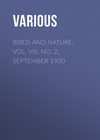Kitobni o'qish: «Birds and Nature, Vol. VIII, No. 2, September 1900», sahifa 5
THE WORSHIP OF NATURE
The ocean looketh up to heaven
As 'twere a living thing;
The homage of its waves is given
In ceaseless worshiping.
They kneel upon the sloping sand,
As bends the human knee,
A beautiful and tireless band,
The priesthood of the sea!
They pour the glittering treasures out
Which in the deep have birth,
And chant their awful hymns about
The watching hills of earth.
The green earth sends its incense up
From every mountain-shrine,
From every flower and dewy cup
That greeteth the sunshine.
The mists are lifted from the rills,
Like the white wing of prayer:
They lean above the ancient hills
As doing homage there.
The forest-tops are lowly cast
O'er breezy hill and glen,
As if a prayerful spirit pass'd
On nature as on men.
The clouds weep o'er the fallen world,
E'en as repentant love;
Ere, to the blessed breeze unfurl'd,
They fade in light above.
The sky is as a temple's arch,
The blue and wavy air
Is glorious with the spirit-march
Of messengers at prayer.
The gentle moon, the kindling sun,
The many stars are given,
As shrines to burn earth's incense on,
The altar-fires of Heaven!
John Greenleaf Whittier.
BIRD-STUDY
To be intimate with Nature is as important to the investigator as the ability to technically classify the things found therein.
In this connection we copy, by permission, the words of Olive Thorne Miller, from the "School Room Methods and Nature Study:"
"Recognizing a bird on sight or hearing, knowing his nest and eggs, when he arrives in the spring, and when he departs in the fall, does not by any means imply that one is acquainted with the bird himself. All these facts are easily acquired; they have been set down in the books these many years.
But whoso really desires to know the little being so beautifully enshrined; to see his home ways with his mate and little ones; to find out his personal habits; his likes and dislikes; his tastes; his disposition; in a word his personality, for him is something very different from book study. He must go into the field and observe for himself; for well as we may know our common birds by sight, glibly as we can explain their anatomy, give their scientific names, and their place in our classification, of their lives and habits we are in almost total ignorance.
This is a field of inquiry as fascinating as it is fresh and unexplored. Nothing but the greed of collecting and the passion for classifying, could so long have blinded men to the charm of studying life instead of death, the individual instead of the skin. And this is the beautiful work left for us to do, to make the world acquainted with the lives of our little brothers in feathers.
For this work are needed, patience that knows no fatigue, accuracy of observation, enthusiasm that scorns such trifles as wet feet, torn garments, insect bites and stings, burning sun or blistering wind, and above all – lacking which all else is useless – truthfulness that will report correctly, without exaggeration or coloring. To one possessing these qualities a whole world of delight is open.
Nor is this world so difficult to enter as it seems at first. Science – whose help is needed – has, to be sure, shrouded itself in technicalities, buried its facts under scientific terms, and hidden its names in a dead language. But all this, which perhaps was necessary, can be got over. With a little courage, and some perseverance, this bristling array of difficulties may be broken through, and the charming goldfinch be as lovely and bewitching under the name of Spinus tristis, as of thistle bird, or yellow bird.
How shall we go to work? This is the first question always. Let me give you a few hints: Some fine morning dress yourself in modest-hued array, dull olive of medium shade best; discard all conspicuous details of costume; take off ribbons and veils, and all fluttering things; reject the spring hat with its eccentricities of flowers, fruits, feathers, or general fluffiness, and put on a plain shade hat, as near the color of the dress as possible; leave parasol, bag or basket and book all at home. Slip into a flat pocket on the outside of your gown or coat, a small note book with sharpened pencil attached to it, and suspend by narrow ribbon around the neck, so that it will hang above the waist and be ready for instant use, an opera glass without its case. On your left arm carry a light folding camp stool – and start out.
Bid adieu to your friends, and go alone, for the temple of Nature can never be entered in crowds, nor even in pairs. Turn your steps to the best place you know of; an old orchard, a grove with underbrush near a house, a ravine, a swamp, or the edge of woods. Walk slowly and leisurely along, with little noise of footsteps, and without swinging arms.
Arrived in your chosen spot look sharply around for the flitting forms of the birds. When you see one, stop at once; quietly slip your stool off your arm and sit upon it, with as little motion as possible. If you place it against a tree trunk, to furnish a back, you can be comfortable in that one position an hour without moving.
Now slowly raise your opera glass to your eyes, adjust the focus to bring the bird clearly before you, and proceed to study him. First you want his description so that you can name him. Look very carefully at him, his size and shape, his coloring above and below, his peculiar markings, the shape of his tail at the end, and the color and shape of the beak. As you settle one point write it in your note book, which you have quietly drawn out of its pocket.
His description recorded, proceed to note his manners; whether quiet or restless, whether he jerks his tail, or his head; walks or hops. See what he is doing; picking up insects, digging them from bark or ground, seeking them among flowers or leaves, or whether he is eating seeds from the grass or weeds. Sit there as long as that bird is in sight, and note down everything he does, even his calls and his song as it sounds to you.
When you go home take your manual and look for a description that matches yours. This is where troubles begin, not only the obscure scientific terms, and the Latin names, but the knowing where in that big book to start. You will be helped by observing what the bird ate. If he hammered on the bark and picked his food from tree trunk or limb, look among the woodpeckers; if he flew out, made a turn or two and back to his perch seek him among the fly-catchers; if he was eating seeds, look among the finches; and so on.
When by a little work you have passed this Rubicon – where so many turn back discouraged – you will reap your reward, success. Having persevered, and named your bird without help, you will feel a new pleasure in his acquaintance, as if he belonged to you, and you will never forget him.
Then go out and make acquaintance with another. You will find him easier to identify, and as you will become familiar with its idiosyncrasies the manual will lose its terrors for you.
Of course all this trouble will be avoided if you begin with the study of scientific ornithology. But in that case you are in danger of becoming absorbed in the science, and getting to care more for the dry bones and the dead skin, than for the living bird, and thus adding one more to the ornithologists, and taking one from the students of life."
THE OREGON JUNCO
Residents of the Atlantic, Middle, Southern and Middle Western States are, doubtless, well acquainted with the slate-colored Junco. This little feathered specimen is more familiarly known as "Snowbird."
The Oregon Junco ("Junco hyemalis var. Oregonus") is a sub-species, and is found throughout the Pacific coast region from California to Sitka. It is, by no means, confined exclusively to Oregon. Its darkest-hued plumage makes the bird very conspicuous when the ground is covered with a soft and spotless mantle of snow.
The sooty-black head, flesh-colored bill and white breast, sharply contrast in color. On the sides are pinkish colored feathers; the back is rufous-brown and the two outer tail feathers pure white, showing when the bird flies. In western Oregon it is a winter visitant, arriving with the first cool days of autumn.
As winter approaches these snowbirds become more plentiful, hopping about in the small bushes in quest of food. A great deal of pleasure and interest may be found in studying these birds, especially when the ground is covered with snow. By casting bread crumbs on the snow, the little fellows flock around, and are easily tamed. In winter their only note is a sort of chirp, sometimes uttered several times in quick succession when alarmed. With the warm days of spring they begin their song, sometimes many singing at once, and soon the majority disappear to a higher altitude to breed.
The Oregon Junco builds its nest in hollows in the ground under low bushes. The nest is constructed flush with the surface and in holes among the roots of bushes and trees, and under woodpiles. Usually, the nest is made of dry grasses rather loosely placed together, with a lining of cowhair, and contains four and sometimes five handsome greenish-white eggs, spotted and wreathed with purple. – J. Mayne Baltimore.
Olive Thorne Miller, in her fascinating little book, "The First Book of Birds," speaking of how the birds work for us, says: "Chickadees like to eat the eggs of cankerworms; and for a single meal one of these tiny birds will eat two hundred and fifty eggs, and he will take several meals a day. Now, cankerworms destroy our apples. When they get into an orchard in force, it looks, as Miss Merriam says, as if it had been burned over. Robins, cat-birds, and shrikes, and several others, like to eat cutworms, which destroy grass and other plants. As many as three hundred of them have been found in the stomach of a robin, of course for one meal. Ants are very troublesome in many ways, and three thousand of them have been taken from the stomach of one flicker."
Why kill these birds that are so useful to us and so beautify nature? Many others are just as useful and some that occasionally do damage amply repay us in other ways.
THE CALICO BASS
The Calico Bass (Pomoxys sparoides) is so called because of the mottled and variegated coloring of the body and fins. It is also called the Strawberry Bass, the Grass Bass, the Bitter Head, the Lamp-lighter and the Barfish.
It is abundant in all the lakes and ponds of the region of the Great Lakes and the upper Mississippi river, where it shows a preference for quiet, cool and clear water and grass covered bottoms.
The Calico Bass is closely related to the Crappie (Pomoxys annularis) of the lower Mississippi valley. It is, however, seldom seen where the Crappie is abundant, as the latter prefers muddy sloughs and bayous and is not found as far north as the former.
The body of the Calico Bass is elongated, is much compressed and of a bright, silvery olive-green color. The sides and fins are mottled with a darker green or brownish-green, the blotches being gathered into irregular bunches. The vertical fins also have markings in the form of a network surrounding paler spots. The mouth is large and oblique. The usual length of the adult is about twelve inches.
The Calico Bass obtains its food largely from the lower forms of animal life, such as crustaceans, worms and insects.
It is said that "from the fact that it thrives well in slow-moving waters, it deserves the favorable consideration of owners of large mill ponds, where there is a steady flow of water, as it requires very little care, except the first planting of it in waters suitable to its nature. It is not averse to an occasional minnow, but is not regarded as peculiarly aggressive, though provided by nature with an armature that enables it to defend itself against all comers."
"Forthwith the sounds and seas, each creek and bay
With fry innumerable swarm, and shoals
Of fish, that with their fins and shining scales
Glide under the green wave, in sculls that oft
Bank the mid sea: part single, or with mate,
Graze, the seaweed their pasture, and through groves
Of coral stray, or, sporting with quick glance,
Show to the sun their waved coats, dropt with gold."
– Milton, "Paradise Lost."










